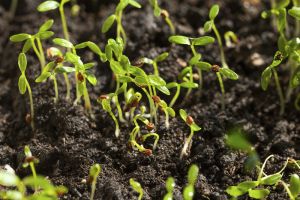Starting Tomatoes Indoors

Is it time? Can I start my tomato seeds yet? We’re all eager for spring, but starting your tomato seeds too early is a bad idea. You don’t want to end up with leggy, weak seedlings do you? Follow these steps for a crop of strong, bushy tomato plants.
Find your last frost date
Check with your Cooperative Extension office or online to find out when the average last frost date for your area occurs. Most tomato seed packets recommend starting seeds indoors six to eight weeks before the last frost. I suggest you err on the side of caution, because the average last frost date is just that — the AVERAGE last frost date, meaning there is still a 50% chance of frost. I’ll never forget the year we had a late frost and had to tarp our tomatoes and rig up a space heater under the tarp. Instead, plan to wait a week or two after your average last frost date to set out your tomato transplants; then start your seeds six to eight weeks before this later set-out date. You’ll be on the safe side and the warmer soil and air temperatures will get your plants off to a robust start.
Give seeds warmth, darkness, and moisture
Tomato seeds need darkness to germinate, which means they should be planted about 1/4 inch deep in a light-weight, sterile potting mix. Moisten the potting mix before you plant, and after planting, cover the flat or pot with a plastic cover or sheet of cling film to retain as much moisture as possible. Seeds may take five to ten days to germinate, and during this time they don’t need light, but they do need warmth! Temperatures between 70 and 80 degrees F are best. If you keep your house on the cool side (like I do) use a heat mat to keep the potting mix warm. These flat, waterproof mats plug into an outlet and provide bottom heat for your seeds and seedlings. Just place your flat or pots on top of the mat. The additional heat makes the soil dry out more quickly, so check soil moisture every other day and water as needed.
Give seedlings lots of bright light
Once your seeds have germinated it is SUPER important to give them as much light as possible or you’ll end up with pale, thin stems and big gaps between leaves. If you have a south-facing windowsill that gets eight to ten hours of direct sun per day, you can grow your seedlings there, but be sure to turn them 180 degrees every day so the stems will be straight. If you don’t have perfect natural light, it’s worth setting up an inexpensive fluorescent shop light. Place the plants just a few inches below the tubes, and as the plants grow, raise the light fixture (most come with adjustable chains) to keep the tubes just barely above the foliage. This close proximity is necessary to encourage thick, dark green stems and bushy leaves. Keep lights on 14-16 hours a day (a timer makes this easy); don’t leave lights on around the clock.
Get your plants ready for the great outdoors
About 7 to 10 days before your setting-out date, it’s time to begin hardening off your seedlings so they’ll be ready for the rigors of the outdoor garden. Hardening off is the process of gradually acclimating seedlings grown indoors to the harsher growing conditions and more intense light they’ll encounter outdoors. Start by placing the seedlings in a sheltered, partly shaded spot outside for a few hours; then bring them indoors at night. Over the next week or so, gradually increase the time the seedlings spend outdoors and the amount of exposure they get to sun and wind, until they are in full sun during the day and outside overnight in their permanent growing location.
Plant deep
Tomatoes can be planted deeper than most other plants because they’ll produce roots on their buried stems, which will give your plants a big, strong root system. If you have a few transplants that are on the spindly side, remove the bottom set of leaves on each and plant the tomatoes extra deep, covering the bare portion of the stems with soil. Once the plants are growing in full sun and a rich soil, their new growth should be strong and lush.
Water your new transplants gently, making sure they remain nice and straight. It’s a good idea to provide supports now, when it’s easier to fit the cages around the plants or drive in stakes without harming the root system. You’ll definitely need those supports in a few months, when your tomato plants are heavy with ripe fruit. I bet you can’t wait!



Leave a Reply
You must be logged in to post a comment.